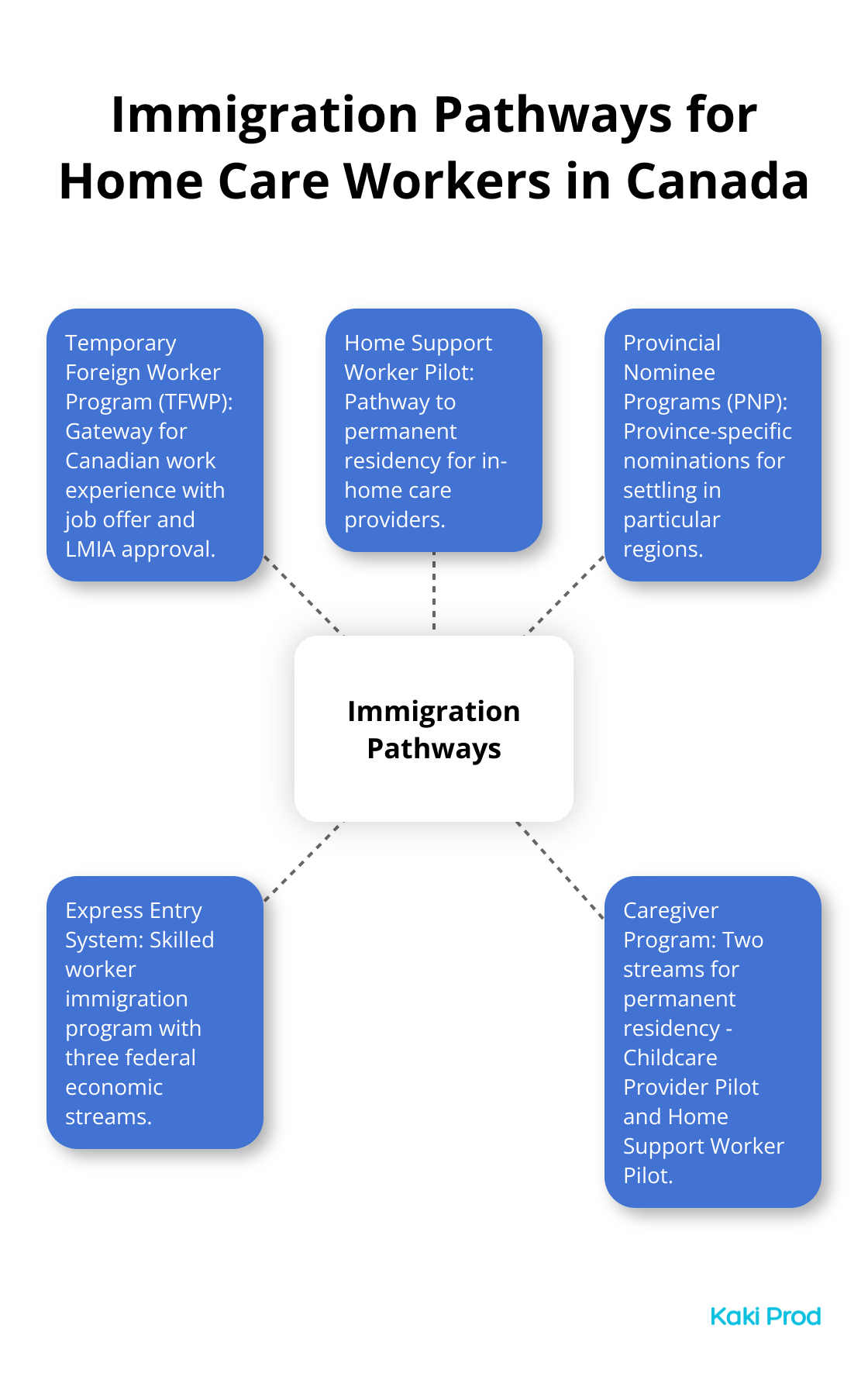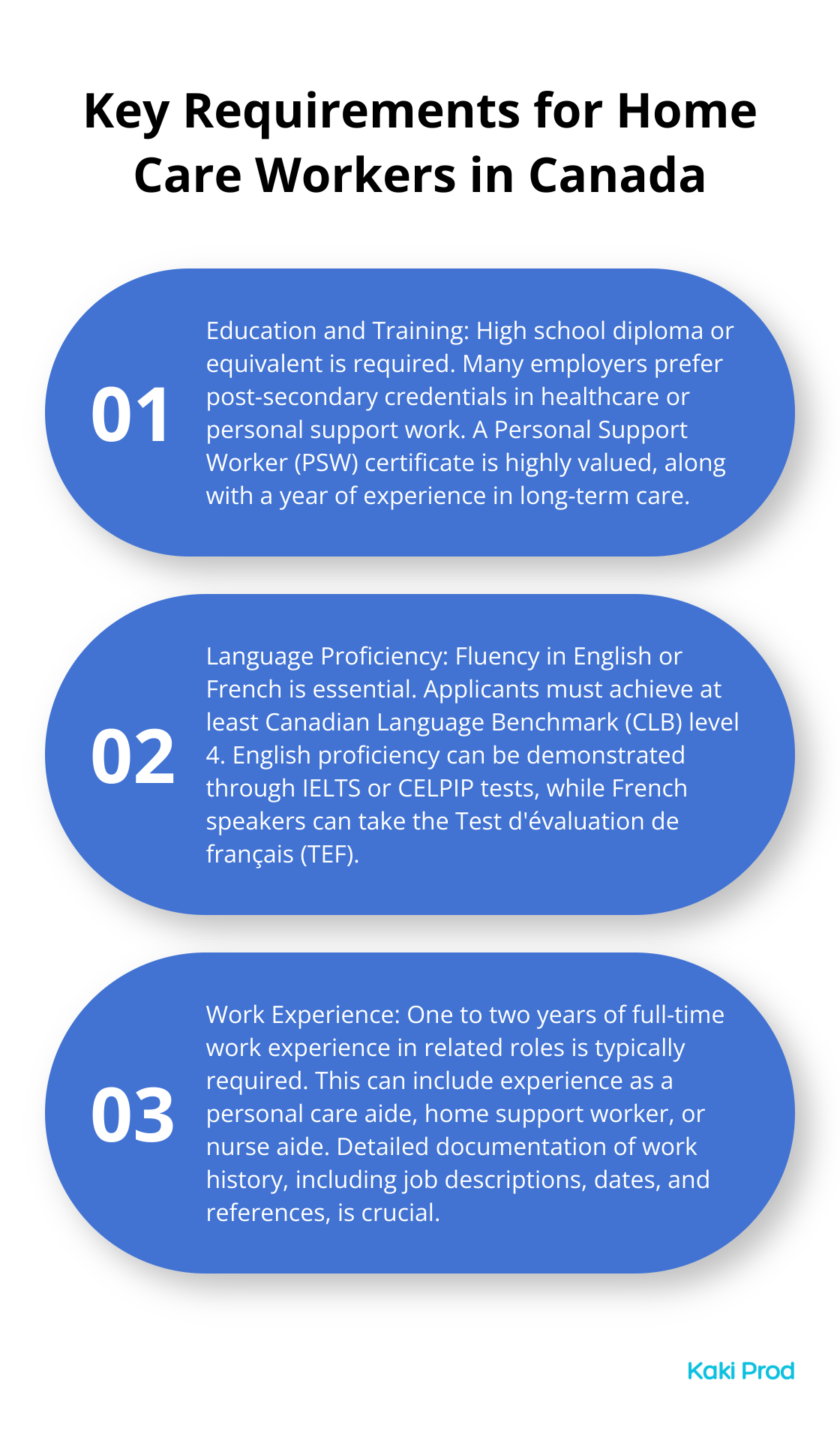Canada’s aging population—yep, that’s right, the boomers are advancing like clockwork—has sparked a booming demand for home care workers. And at Kaki Prod, we’re seeing this play out in real time, like, “news flash: supply can’t keep up with demand.”
So, what’s the fix? Immigration pathways (yep, we’re talking about welcoming talent from beyond our borders) could slam-dunk this issue by bringing skilled foreign workers into these all-important roles. In this post, we’ll dive into the nitty-gritty of various immigration options for home care workers and what hoops they need to jump through to set up shop in Canada.
Why Canada Needs Home Care Workers Now
The Soaring Demand for Care
So get this, Canada is in a huge pickle – there’s an insane demand for home care workers. Seriously, over the next 20 years, the number of folks aged 65 and older in Canada is gonna balloon by 68%. Yep, you heard right. We’re talking about a tidal wave of elders needing care in their homes.

Current Shortage Crisis
The reality? Canada is strapped for home care pros – really strapped. It’s not just home care, either. They’re short on doctors, nurses, and pretty much all kinds of care providers. Result? A serious hole in the healthcare safety net.
Aging Population: A Demographic Tsunami
By 2036, Canada’s seniors will make up a hefty chunk of the population pie. And the number of folks 75 and up? It’s gonna skyrocket. This isn’t just a trend – it’s a demographic tsunami barreling toward us.
Government Takes Action
So, how’s Canada tackling this? They’ve rolled out the Home Care Worker Immigration Pilots starting March 31, 2025, opening doors to permanent residency for home care workers. It’s a strategic play to bring in international talent and plug the expanding gap.
But wait- there’s more. The government’s also pumping funds into training and tech to bolster the sector. Remote patient monitoring, telehealth – all that jazz-is growing fast, helping make care more efficient and way more accessible.
Technology Transforms Care Delivery
The tech revolution – IoT, anyone? – in home care is blasting off, catalyzed by the COVID-19 pandemic. Home health monitoring, personalized care plans designed just for you – these aren’t future dreams; they’re happening now. We’re shifting to shared decision-making, prioritizing what clients want.
With demand for home care workers climbing the charts-thanks to an aging populace and technological leaps-the next big thing is exploring the immigration doors swinging open for those eyeing a role in Canada’s evolving healthcare narrative.
How Can Home Care Workers Immigrate to Canada?
Alright, let’s break this down. Canada? Loves them some skilled caregivers. So, lucky for home care workers eyeing the Great White North, there are a bunch of immigration pathways ready for the taking. It’s not just about filling a job-there’s career and future in it.
Temporary Foreign Worker Program
First up-Temporary Foreign Worker Program (TFWP). Think of it as your opening act. It lets Canadian bosses fill those temporary labor gaps with talent from abroad. So, if you’re a home care worker, this is your gateway to Canadian work experience.
Here’s the breakdown: You need a job offer from a Canadian employer and a thumbs-up in the form of a Labour Market Impact Assessment (LMIA). Essentially, the LMIA is proof-no Canadian can or will do the job. But, here’s the kicker-it could take a few months to sort out all the nitty-gritty.
Home Support Worker Pilot
Now, onto something a bit more permanent-the Home Support Worker Pilot. It’s your golden ticket to permanent residency. This pilot zeroes in on those providing in-home care-meeting someone’s daily needs-right in their private abode.
Provincial Nominee Programs
And hey, don’t forget the Provincial Nominee Programs (PNP). Each Canadian province runs its own show here. They’ve got the power to nominate folks who want to set up shop in their specific region. You’ll find plenty of pathways catering to healthcare beings eager to make the leap to Canada.
Express Entry System
Then, there’s the big dog-Express Entry. It’s Canada’s top-shelf immigration program tailored for skilled workers. Home care workers aren’t the main focus, but-if you’ve got the education and language chops-this could be your jam.
Three federal economic programs under this umbrella:
- Federal Skilled Worker Program
- Federal Skilled Trades Program
- Canadian Experience Class
You throw together an online profile, get ranked based on age, smarts, work background, and language prowess-top dogs get the invite for permanent residence.
Caregiver Program
Lastly, dive into the Caregiver Program if going permanent is your game. Two streams run this show:
- Childcare Provider Pilot
- Home Support Worker Pilot
Both angles let you snag permanent residency and, bonus, bring your fam along for the ride.
Bottom line-immigration policies aren’t set in stone. Stay sharp to catch how the winds of policy change shift. Up next-requirements and qualifications to nail these pathways as a home care worker in Canada.

What Does It Take to Qualify as a Home Care Worker in Canada?
So, you’re eyeing a gig in Canada’s home care sector? Brace yourself; they want the real deal. To step into this world as a home care worker, there are a few hoops you’ve got to jump through. Let’s dissect this.
Education and Training Requirements
First things first-school. Almost everywhere, they want that high school diploma (or its equivalent). But wait-higher stakes, higher bets. Many bosses are keen on post-secondary credentials, especially in healthcare or personal support work. It’s like showing up to a knife fight with a lightsaber.
Now, that Personal Support Worker (PSW) certificate is your ace in the hole. These gigs want folks who’ve mastered the art of mixing textbook smarts with hands-on know-how. And once you’re done with all that, plan on investing a year in long-term care-where the real learning begins.
Language Proficiency
In healthcare, you can’t afford to be a mime. You’ve got to prove you’re fluent in English or French. Our friends at the Canadian Language Benchmark (CLB) have set the gold standard here. So, level 4? Yeah, that’s your north star.
For English, grab the International English Language Testing System (IELTS) or the Canadian English Language Proficiency Index Program (CELPIP)-they’re your litmus test. If French is your jam, go with the Test d’évaluation de français (TEF). It’s all about speaking in tongues-just the right ones.
Work Experience
What’s Canada’s secret sauce? Practical experience. Seriously, you’ll need a good one to two years of full-time work in related gigs. Whether you’re a personal care aide, home support worker, or a nurse aide, those hours count like gold.
Treat your work history like a treasure map-document everything. Job descriptions, dates, references-they’re your holy grail when it’s time to make your case.
Job Offer and LMIA Process
Entering the Canadian workforce often means having a ticket-a valid job offer from a Canadian employer. And it comes with a buddy-a Labour Market Impact Assessment (LMIA).
LMIA is like the permission slip for your potential employer to bring you onboard. They’ll run the show for most of it, but don’t be that person who’s caught off guard-have your docs ready to keep the train moving.
Quick tip: Keep your finger on the pulse of the immigration landscape. It’s a game of chess, not checkers. Moves change, updates roll in, and being in the know is your best play.

Final Thoughts
Alright, folks, let’s dive in. Canada’s home care sector-ever heard of it? It’s a goldmine of opportunities for foreign workers keen on a career switch. With various immigration pathways, qualified folks can step up and support Canada’s aging population. But it’s not just about fulfilling needs; it’s a two-way street. Canada fills its worker shortage, and foreign workers get a shot at a fresh start in a country people rave about for its quality of life.
But hey, let’s not sugarcoat it. Becoming a home care worker in Canada? It takes dedication. But trust me… the rewards? Totally worth it. Nail those education, language, and work experience requirements, and you’re looking at a stable career-one with growth potential and job security. Plus, the satisfaction of making a real impact? Priceless.
At Kaki Prod, we’re all about helping people grow-both personally and professionally. Our platform is packed with resources and insights to guide you on your journey to becoming a home care worker in Canada. The demand is there, and it’s only going up. So, if you’re qualified, now might just be the perfect time to leap into this fulfilling career path.

